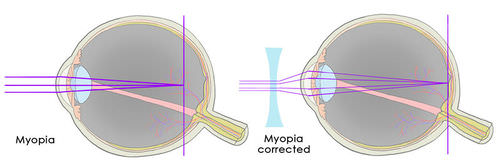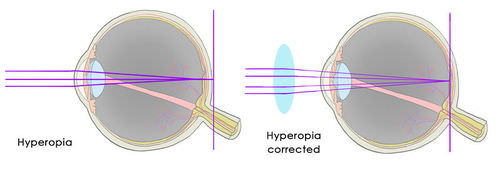19.11 视觉问题和矫正镜头
章节大纲
-
If you’ve ever had your vision checked, you’ve no doubt been asked to read an eye chart like the one in this cartoon. The patient in the cartoon must be having trouble making out the letters in the second row of the chart, because he asks the doctor for a hint (in the style of a popular TV game show). The patient clearly has a vision problem.
::如果你的视力被检查过,毫无疑问,你被要求阅读像这幅漫画中那样的眼图。 卡通中的病人一定很难在图表第二行写出字母,因为他要求医生提示(用流行电视游戏节目的风格 ) 。 病人显然有视觉问题。Problems with Vision
::展望问题Many people have problems with their vision , or ability to see. Often, the problem is due to the shape of the eyes and how they focus light. Two of the most common vision problems are nearsightedness and farsightedness, which you can read about below. You may even have one of these vision problems yourself. Usually, the problems can be corrected with contact or lenses in eyeglasses. In many people, they can also be corrected with laser surgery, which reshapes the outer layer of the eye.
::许多人的视力或视觉能力有问题。通常,问题在于眼睛的形状和它们如何聚焦光线。两种最常见的视力问题是近视和远视,您可以在下文中看到。你甚至可以自己看到其中一种视力问题。通常,这些问题可以通过眼镜中的接触或眼镜来纠正。在许多人中,他们也可以通过激光手术来纠正,而激光手术可以改变眼睛的外层。Nearsightedness
::近视Nearsightedness, or myopia, is the condition in which nearby objects are seen clearly, but distant objects appear blurry. The Figure shows how it occurs. The eyeball is longer (from front to back) than normal. This causes images to be focused in front of the retina instead of on the retina. Myopia can be corrected with concave lenses. The lenses focus images farther back in the eye, so they fall on the retina instead of in front of it.
::近视或近视是近距离物体被清晰地看到的状况,但远方物体似乎模糊不清。 图显示其是如何发生的。 眼球( 从前到后)比正常的要长。 这导致图像集中在视网膜前而不是视网膜上。 近视镜可以用凝固的镜片来纠正。 镜片将焦点图像放在眼睛后更远的地方, 因此它们会掉在视网膜上, 而不是放在视网膜前 。Q: Sometimes squinting the eyes can help someone see more clearly. Why do you think this works?
::问题:有时斜视眼睛可以帮助人们看得更清楚。你觉得这有什么用?A: Squinting may improve focus by slightly changing the shape of the eyes. When you squint, you tighten muscles around the eyes, putting pressure on the eyeballs.
::A: 斜眼可以通过稍微改变眼睛的形状来改善焦点。 斜眼看时, 紧紧眼睛周围的肌肉, 对眼睛施压 。Farsightedness
::远视Farsightedness, or hyperopia, is the condition in which distant objects are seen clearly, but nearby objects appear blurry. It occurs when the eyeball is shorter than normal (see Figure ). This causes images to be focused in a spot that would fall behind the retina (if light could pass through the retina). Hyperopia can be corrected with convex lenses. The lenses focus images farther forward in the eye, so they fall on the retina instead of behind it.
::远视或超视率是看得很清楚的远方物体,但附近物体看起来模糊不清。当眼球短于正常时就会发生(见图 ) 。 这导致图像集中在视网膜后面的某个位置( 如果光能穿过视网膜的话 ) 。 超视镜可以用锥形镜进行矫正。 镜片的焦点图像在眼睛前方更远, 因而它们会落在视网膜上而不是视网膜后面 。Q: Joey has hyperopia. When is he more likely to need his glasses: when he reads a book or when he watches TV?
::问:乔伊有超opia。他什么时候更需要他的眼镜?当他看书或看电视的时候?A: With hyperopia, Joey is farsighted. He can probably see the TV more clearly than the words in a book because the TV is farther away. Therefore, he is more likely to need his glasses when he reads than when he watches TV.
::甲:高视率,乔伊是远见卓识的。 他看电视可能比看一本书的字眼更清楚,因为电视离得更远。 因此,他阅读时比看电视时更需要眼镜。In the Contact Lens simulation below, the Lens Slider allows you to choose between a converging (convex) contact lens and a diverging (concave) contact lens. Play around looking at different objects at different distances using these two lenses and try to determine what is the best shape for the contact lens:
::在下面的“接触镜头”模拟中,“镜头滑动器”允许您在聚合(Convex)隐形眼镜和不同的(Concave)隐形眼镜之间做出选择。使用这两个镜头在不同距离对不同对象进行环视,并尝试确定隐形眼镜的最佳形状:Summary
::摘要-
Many people have vision problems. Often, the problem is due to the shape of the eyes and how they focus light. Two of the most common vision problems are nearsightedness and farsightedness.
::许多人有视觉问题,问题往往在于眼睛的形状和它们如何聚焦光线,最常见的两个视力问题是近视和远视。 -
Nearsightedness, or myopia, is the condition in which nearby objects are seen clearly, but distant objects appear blurry. The eyeball is longer than normal, focusing images front of the retina. Concave lenses can correct the problem.
::近视或近视是近距离物体被清晰地看到的状况,但远距离物体似乎模糊不清。眼球比正常时间长,将图像聚焦在视网膜前。隐形眼镜可以纠正问题。 -
Farsightedness, or hyperopia, is the condition in which distant objects are seen clearly, but nearby objects appear blurry. The eyeball is shorter than normal, focusing images behind the retina. Convex lenses can correct the problem.
::远视或超视率是清晰观察远方物体的状态,但附近物体似乎模糊不清。眼球短于正常,将图像聚焦在视网膜后面。 Convex 镜片可以纠正问题。
Review
::回顾-
Compare and contrast myopia and hyperopia.
::比较和对比近视和超常opia。 -
Explain how lenses can be used to correct vision problems.
::解释如何利用透镜纠正视力问题。
-
Many people have vision problems. Often, the problem is due to the shape of the eyes and how they focus light. Two of the most common vision problems are nearsightedness and farsightedness.


